Table of contents
Cranberries ( Vaccinium macrocarpon ), also known as cranberries, large-fruited cranberries or craneberries They are dried and sweetened and used in muesli, desserts, baked goods, and also in salads and sauces. Whether dried cranberries are raw depends on the drying process. Organic quality is preferable.
Use in the kitchen
Cranberries, often written as cranberries, are mainly sold dried and sweetened. 1 What do dried cranberries taste like? The sweetened, dried cranberry has a sweet and sour taste with a slightly bitter note and a soft, sticky consistency. Sugar or other sweeteners are often added to dried fruits such as dried cranberries to reduce the water content and improve the consistency and palatability. 2
How do you eat cranberries? The mostly dark red to black fruits are dried and sweetened and represent an interesting alternative to raisins . They are popular as a snack between meals, as an addition to muesli (try Erb-Müesli ), porridge or yoghurt or as a baking ingredient for pastries, bread (e.g. apple bread with nuts and cranberries ), muesli bars (e.g. energy bars with berries, ginger and nuts ) or vegan desserts such as cakes, Christmas stollen, cookies and tarts. The dried and sweetened berries can also be used to make a heavenly Kaiserschmarrn . They also taste great in fruit salads, smoothies or made into compote.
Dried, sweetened cranberries are also suitable for refining salty dishes. They give vegan salads and bowls a fruity, sweet and sour note. The berries are particularly recommended for adding to salads such as Waldorf salad (with celeriac and apples ), coleslaw (e.g. with white cabbage or red cabbage and carrots ), lamb's lettuce, rocket salad, but also couscous, quinoa or bulgur salad. Cranberries can also be used to refine and spice up sauces (e.g. tomato sauce) and seasoning sauces (e.g. vegan BBQ sauce). Cranberries (fresh or dried) are also used to make the famous cranberry sauce, which is a must at any Thanksgiving meal (vegan is also possible).
Another recommended recipe with dried, sweetened cranberries is the oriental cauliflower with cumin, cinnamon, cranberries and walnuts , which is best served with wholegrain rice, quinoa or spelt . The berries also taste great sprinkled over vegan tarte flambée or in rice pans and give many dishes that certain something.
By the way: In recipes with fresh cranberries, you can easily replace them with dried ones. 100 g of fresh produce corresponds to about 50 g of dried cranberries. Depending on the recipe, it is advisable to soak the dried berries in water, cranberry juice or apple juice for a few hours. This way they expand a little, are softer and have a different bite.
Cranberries taste wonderful with seeds and nuts (e.g. in trail mix). Spices such as cinnamon, cloves and ginger or herbs such as basil, rosemary and sage complement and round off the sweet-sour, tart taste of the dried, sweetened cranberries.
Drying
fresh cranberries yourself is easy, but it does take a little time. It is still worth it, as it gives you unsweetened, dried cranberries. You can proceed as follows:
Wash ripe, undamaged berries, dry them and prick each one once so that the liquid can escape as they dry. Spread the cranberries on a baking tray lined with baking paper - make sure that the berries do not lie on top of each other. Dry in the oven at 40-60 °C (for raw food max. 42 °C) and leave the oven door slightly open (eg using a wooden spoon wedged in) so that moisture can escape. Cranberries are completely dried when they are shriveled and sticky. This can take up to 24 hours. Fill, seal well and store at room temperature.
Alternatively, you can dry the fruit in a dehydrator. Air drying is not advisable as it takes several days (optimal weather is a prerequisite) and is very unlikely to produce the desired result.
Vegan recipe for lamb's lettuce with dried cranberries
Ingredients (for 2 people): 300 g lamb's lettuce, 1 green apple, 100 g dried and sweetened cranberries (organic), 50 g walnuts, 2 tbsp rapeseed oil, 2 tbsp apple juice, 1 tbsp white wine vinegar, 1 tbsp apple syrup, 1 tbsp mustard, a little salt andpepper .
Preparation: Wash the lamb's lettuce and spin dry. Rinse the apple and cut into thin slices. For the dressing, mix the rapeseed oil, apple juice, white wine vinegar, apple syrup and mustard and season with salt and pepper. Arrange the lamb's lettuce on two plates. Distribute the apple pieces, cranberries and walnuts on top. Pour the dressing over the vegan autumn salad and serve.
Vegan recipes with cranberries (dried, sweetened) can be found under the note: " Recipes that have the most of this ingredient ".
| Not only vegans or vegetarians should read this: Vegans often eat unhealthily. Avoidable nutritional errors . |
Purchasing - Storage
Dried and sweetened cranberries are available in most supermarkets (e.g. Coop, Migros, Denner, Volg, Spar, Aldi, Lidl, Rewe, Edeka, Hofer, Billa ) and organic supermarkets (e.g. Denn's Biomarkt, Alnatura ), in organic quality and available all year round . Information on the season for the fresh ingredient can be found under Cranberries, raw .
Are there dried cranberries sweetened with apple juice? They differ in the type of sweetening. Most are sweetened with sugar (sweetened), others with fruit juices or fruit juice concentrates (e.g. apple juice, apple juice concentrate, pineapple syrup). Unsweetened dried cranberries are most likely to be found in health food stores or online.
Whether dried cranberries are raw food products depends on the drying process used. For a food to be considered raw, drying temperatures must be below 42 °C. Freeze-dried dried fruit can be considered raw.
The availability of cranberries (dried, sweetened) varies depending on the size of the store, catchment area, etc. You can find our recorded food prices for the DA-CH countries above under the ingredient image - and by clicking you can see their development at various suppliers.
Storage tips
If stored airtight, dry and at room temperature, dried cranberries (sweetened or unsweetened) will last for at least a year, but often much longer.
Ingredients - Nutritional values - Calories
How many calories are in dried cranberries? Cranberries, dried and sweetened, contain 308 kcal per 100 g, which come primarily from carbohydrates (83 g/100g, of which 73 g sugar). The very high sugar content is comparable to that of dates (eg Medjool ; 66 mg/100g) and candied lemon peel (70 g/100g). Other dried but unsweetened fruits, such as dried pears (62 g/100g), dried mango (60 g/100g) and raisins (dried grapes; 59 g/100g) also contain a lot of sugar, but still slightly less. Both the protein content (0.17 g/100g) and fat content (1.1 g/100g) are low. It contains a relatively high amountof fiber, at 5.3 g/100g. 3
100 g of dried, sweetened cranberries contain 2.1 mg of vitamin E (18% of the daily requirement).Dried pumpkin seeds contain comparable amounts (2.2 mg/100g). Dried and unsweetened dried fruit such as goji berries (8 mg/100g), mango (4.4 mg/100g) and apricots (4.3 mg/100g) contain more, while other dried fruit such as raisins (0.12 mg/100g), sour cherries (0.36 mg/100g) and apples (0.53 mg/100g) contain less. Almonds are particularly rich in vitamin E with 26 mg/100g . 3
Do cranberries contain vitamin K? Cranberries (dried, sweetened) contain 7.6 µg/100g of vitamin K (10% of the daily requirement). This content is comparable to that of dried, unsweetened sour cherries (11 µg/100g). Slightly more can be found in dried peaches (16 µg/100g), dried figs (16 µg/100g) and dried pears (20 µg/100g). At 60 µg/100g , dried plums contain almost eight times as much vitamin K. 3
Dried, sweetened cranberries contain 0.18 mg of manganese per 100 g (9% of the daily requirement), similar to dried apricots (0.24 mg/100g), dates ( Deglet Nour ; 0.26 mg/100g) and raisins (0.3 mg/100g).Dried bananas (0.83 mg/100g), dried goji berries (0.8 mg/100g) and dried mango (0.8 mg/100g) contain more of the trace element, but not nearly as much as, for example, pine nuts (8.8 mg/100g) or pecans (4.5 mg/100g). 3
Secondary plant substances contained in cranberries include phenols such as phenolic acids and flavonoids, including anthocyanins (responsible for the red to black pigmentation of the berries), proanthocyanidins, flavonols and flavan-3-ols, and carotenoids such as β-carotene, lutein and zeaxanthin. 4,5
The complete ingredients of cranberries (dried, sweetened), the coverage of the daily requirement and comparison values with other ingredients can be found in our nutrient tables. In the article Nutrients explained you will get a detailed insight into the topic.
Health Benefits
Are dried cranberries healthy? Dried cranberries are said to have a number of health benefits, including supporting the health of the urogenital system (urinary and reproductive organs) and the digestive system. 6,7
The consumption of cranberries ( Vaccinium macrocarpon ) has long been associated with the preventive effect on urinary tract infections. Originally, it was assumed that the positive effect was due to the fruit acids, which have a bacteriostatic effect (inhibiting the growth and proliferation of bacteria) in the urine. However, a group of proanthocyanidins was found in the berry that can inhibit the adhesion of uropathogenic bacteria such as p-fimbriated Escherichia coli (responsible for a large proportion of urinary tract infections) to the mucous membrane of the urinary tract, but also of Helicobacter pylori (can cause stomach cancer) to the stomach mucous membrane. The proanthocyanidins in question can be detected in both fresh and dried cranberries. 8,9,10
The results of a 2010 study also showed that eating dried cranberries improved prostate health in men with elevated PSA levels (which may indicate prostate cancer), histologically proven prostatitis (inflammation of the prostate), or bladder emptying problems. 11
The proanthocyanidins contained in cranberries are also said to have an inhibitory effect on oral diseases such as caries and periodontitis. However, the cariostatic effects of cranberries have mostly only been demonstrated in laboratory studies, which requires clinical studies to confirm them. 8,9 But be careful: dried cranberries are mostly sweetened, which in turn promotes caries.
A 2018 study showed that daily consumption of dried, sweetened cranberries for two weeks affected the composition of the proteome (total proteins) in urine and the microbiome (total microorganisms) in stool. The experiment increased the number of proteins found in healthy human urine by about 10% and led to a shift in the ratio of the main gut bacteria phyla Firmicutes and Bacteroidetes in favor of Bacteroidetes, which is associated with more successful weight management. It also found an increase in commensal (non-harmful) bacteria and a decrease in harmful bacteria in the gut. 6
Cranberries are said to have antioxidant and antimicrobial properties due to the phenols they contain. 1 Other alleged health benefits of eating cranberries include reducing the risk of cardiovascular and neurological diseases, modulating inflammatory responses and inhibiting the proliferation of cancer cells. 9
Dangers - Intolerances - Side effects
Can you lose weight with dried cranberries? Dried cranberries are mostly sweetened with sugar or other sweeteners. Carbohydrates, primarily sugar, are therefore the main component of dried, sweetened berries. Excessive carbohydrate and sugar consumption is linked to diseases such as diabetes and obesity. You should make sure to consume them in moderation. It is best to choose unsweetened, dried cranberries anyway - they are healthier and better for weight management.
The glycemic index (GI) of dried, sweetened cranberries is 62. In comparison, granulated sugar has a GI of 65. 12 ,13
Like other sweetened foods, dried, sweetened cranberries are harmful to oral health and teeth. After consumption, you should rinse your mouth with water and brush your teeth. Consuming them in moderation reduces the risk of tooth damage.
Folk medicine - natural medicine
In America, natives used cranberries as a meat preservative and as a medicine to relieve various ailments, from scurvy to stomach and liver problems. 9 Cranberries were also used to treat arrow wounds. 16
Ecological footprint - animal welfare
The ecological footprint of a food depends on various aspects, such as cultivation method (conventional/organic), seasonality, country of origin, processing, transport and, if applicable, packaging. According to the Danish climate database Concito, the CO 2 footprint of raw cranberries is 0.73 kg CO 2 eq/kg. 14 We were unable to find a trustworthy source for the CO 2 footprint of dried and sweetened cranberries in particular. However, the value is probably higher due to additional processing (drying processes). To illustrate: grapes have 0.8 kg CO 2 eq/kg and raisins have a value of 3.16 kg CO 2 eq/kg. 14
A large proportion of the cranberries in European supermarkets come from North America (USA, Canada). The transport distances are therefore relatively long. If possible, choose cranberries grown in Europe or opt for raisins .
According to a Dutch study (2011), the water footprint of raw cranberries is 276 litres of water per 1 kg of cranberries. 15
For detailed explanations of various sustainability indicators (such as ecological footprint, CO2 footprint, water footprint), see our article: What does the ecological footprint mean?
In conventional agriculture, synthetic pesticides and herbicides are often used to combat unwanted plants and insects. These have been proven to have a negative impact on the environment and affect important pollinators, birds and mammals. Accordingly, when buying cranberries, you should buy organic products to protect biodiversity and your own health. The use of such pesticides is prohibited in organic farming.
Worldwide occurrence - cultivation
Native Americans were the first to use cranberries and discovered the versatility of the berries. They used cranberries in a variety of foods. The most popular was pemmican, a protein-rich mixture of dried meat, fat and cranberries. They also used the berries as a dye for carpets and blankets. 16
The largest cranberry producers in 2022 were the USA, Canada and Turkey. In Europe, Ukraine, North Macedonia, Belarus and Azerbaijan are among the largest growing areas. 17
About 95% of the harvested raw cranberries are processed into products such as juice drinks, sauces and sweetened dried cranberries. The remaining 5% are sold fresh. 16
Read more about growing and harvesting raw cranberries in the accompanying article.
Industrial production
A large proportion of fresh cranberries are subjected to osmotic dehydration in sugar solutions in order to enrich them with a sweet taste and to remove water from the tissue. This is done by diffusing sugar from the solution into the cranberries and at the same time water from the berries passes into the solution. The osmotically dehydrated cranberries are then dried further to obtain a product ready for consumption. 18
The traditional osmotic dehydration of fruit is mainly carried out in hypertonic solutions of sucrose (granulated sugar) or glucose. Alternatives are fruit juice concentrates or sugar substitutes such as steviol glycosides. 18
To improve water removal, different types of pretreatment can be used, such as cutting or blanching. Non-thermal technologies for pretreatment include pulsed electric fields or ultrasound. 18
The results of a 2019 study showed that blanching or the combination of blanching with pulsed electric fields and ultrasound of cranberries can shorten the drying time compared to traditionally pretreated, i.e. cut, cranberries. No negative effects on the concentration of bioactive substances or the color of the final product were observed. If the osmotic dehydration in sugar solutions is reduced by applying pretreatments, the cranberries accumulate less sugar. A reduced sugar content is the result. 18
When raw cranberries are processed into sweetened, dried cranberries, some bioactive compounds are lost. To minimize the degradation of some of these substances, such as polyphenols, processing and storage parameters could be optimized. Examples of this include reducing the time and temperature of the drying process and using other packaging materials that prevent oxidation more effectively, according to a 2020 study. 5
Freeze-drying is another type of drying and, according to a 2012 study, resulted in no detectable loss of bioactive compounds such as anthocyanins and proanthocyanidins from cranberries. 8
Further information
Cranberry ( Vaccinium macrocarpon ) is a species of plant in the heather family (Ericaceae), which also includes cranberries ( Vaccinium vitis-idaea ) andbilberries/blueberries ( Vaccinium myrtillus ). The evergreen, creeping shrub grows in cool, temperate areas with acidic soils and in peat bogs in the northeastern United States and southern Canada. There are many varieties of this species, most with reddish berries. The white cranberry is an early ripening variety that is picked two to three weeks before ripeness. 16
The correct German name for the species is actually Grossfrüchtige Moosbere, but the English name is more common. "Cranberry" is said to be derived from the Pilgrims' name for the fruit "craneberry" because the small, pink flowers that appear in spring resemble the head and beak of a sandhill crane. 16
In addition to the most well-known representative of the cranberries, the large-fruited cranberry ( Vaccinium macrocarpon ), there are also the small-fruited cranberry ( Vaccinium microcarpum ), the southern cranberry ( Vaccinium erythrocarpum ) and the common cranberry ( Vaccinium oxycoccus ), which are native to Central and Northern Europe. 9
Are cranberries and lingonberries the same thing? Cranberries ( Vaccinium macrocarpon ) and lingonberries ( Vaccinium vitis-idaea ) are not the same. Although they are both red berries of the blueberry genus ( Vaccinium ), they differ visually, but mainly in terms of their size. Cranberries are significantly larger than the pea-sized lingonberries. Cranberries originate from North America, while lingonberries are native to Europe and Asia. The confusion between cranberries and lingonberries arose because of the confusing name for cranberries as "cultivated lingonberries" when they were introduced to the market.
We also have articles about the following dried fruits: pears, mango, raisins, apricots, goji berries, apples ,bananas, plums, sour cherries, figs, peaches and dates ( Medjool variety, Deglet Nour variety).
Alternative names
The cranberry is also known as the large-fruited cranberry, American cranberry, American craneberry or craneberry. The correct plural is cranberries, but due to the English plural form it is often written as cranberries.
In English they are called dried, sweetened cranberries.

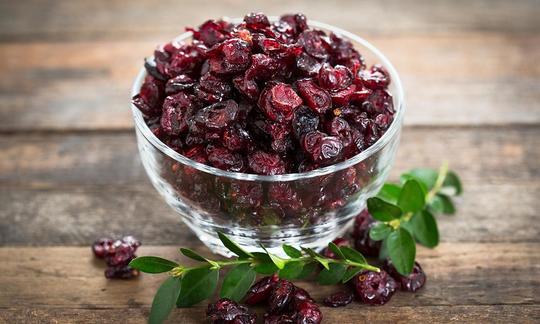

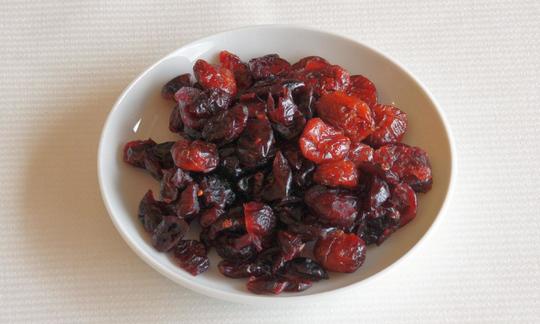

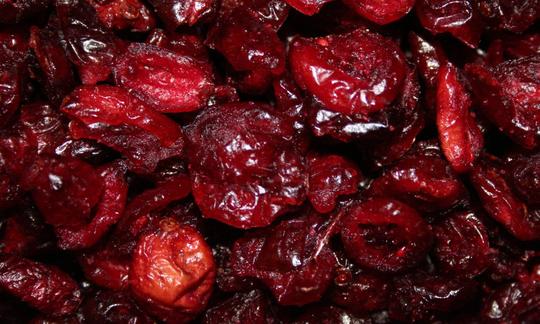


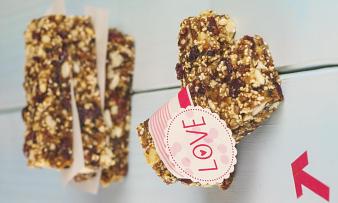
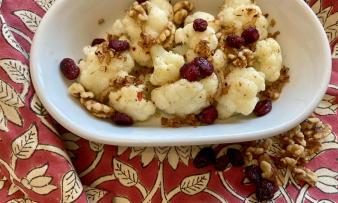





Comments